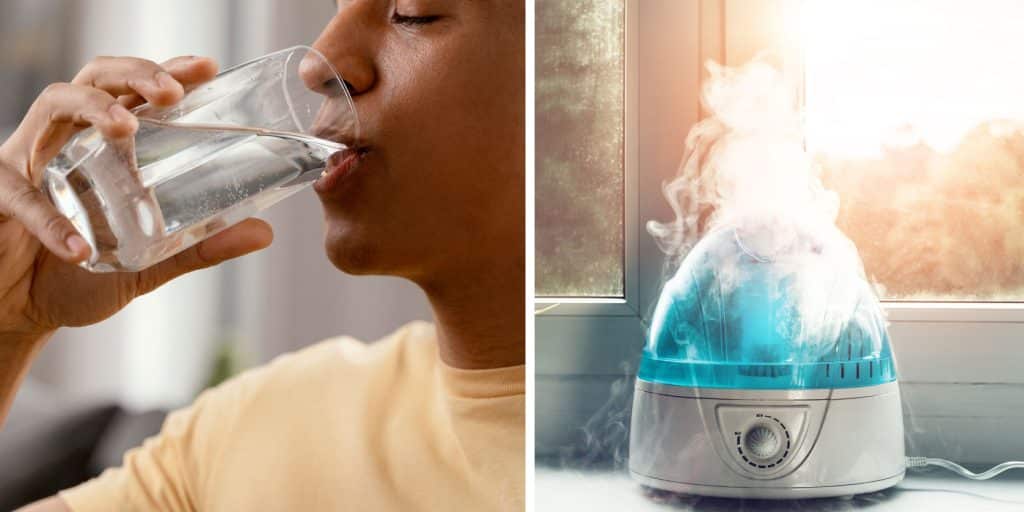You start your day feeling normal, but as the hours tick by… Ahhhhhhhh-choo! You start to feel worse and worse. Your head feels fuzzy. Your nose is stopped up. Your throat is sore. Your mom’s voice nags in the back of your head, “honey, you really should be in bed!” There’s a good chance you’re suffering from a common condition called an upper respiratory infection (URI).
URIs are among the most common types of illnesses. But, do we really need to tell you that? You probably have at least one each year. In 2019 alone, there were over 17 billion recorded cases worldwide. But URIs are not one single illness, so let’s explore what they are, how to recognize them, and what you can do if you get sick.
What is an upper respiratory infection?
Take a minute, and (if you can) inhale a big breath, hold it for a second, and let it out with a big “whoooooo” sound. Your respiratory system includes your lungs, nose, mouth, throat, voice box, windpipe, and diaphragm. It’s all the body parts used to do that breathing activity you just did. It’s divided into the upper respiratory system, which includes the nose, nasal cavity, mouth, throat, and voice box, and the lower respiratory system, which primarily includes the windpipe and lungs.
An infection happens when a virus or bacteria enters and invades your respiratory tract. You might have touched an infected surface or shaken hands with an infected person, then touched your mouth or nose. There’s a reason why doctors, nurses and elementary teachers remind everyone in their midst to “wash your hands!” and “stop touching your face!” These infections are more common than infections in other parts of your body because of how exposed your mouth and nose are to the world around you. Your upper or lower respiratory systems can become infected, but LRIs (lower respiratory infections) are often more severe.
Some common types of URIs include:
- Common colds
- Laryngitis (inflammation of your voice box)
- Pharyngitis (sore throat)
- Sinus infection
- Epiglottitis (inflammation at the back of your throat under your tongue)
Upper respiratory infection symptoms
Symptoms vary depending on the type of infection, but there are some that pop up in most cases. These include:

- Coughing
- Fever
- Runny nose
- Scratch or sore throat
- Pain when swallowing
- Sneezing
- Nasal congestion (trouble breathing through nose)
Some less common symptoms include:
- Diarrhea
- Headache
- Bad breath
- Body aches
- Vomiting
- Shortness of breath
- Watery/itchy eyes
- Vomiting
So as you can tell, URI symptoms are generally unpleasant. Again depending on the type of infection, symptoms often last between a few days and two weeks.
Home remedies for an upper respiratory infection
The vast majority of upper respiratory infections are viral infections, which means unfortunately antibiotics won’t work to cure them. The good news is that most URIs don’t need medical intervention. If you support your body’s immune system, they’ll usually pass on their own. But there are some steps you can take to help make the symptoms less unpleasant and the infection pass more quickly. Before you run over to the pharmacy or doctor’s office, try these:

- Stay hydrated – Water is usually your best choice, but juice and lemon water can help too. The most important thing is to avoid drinks that will dehydrate or weaken your immune system like caffeine and alcohol. As tired as you feel, steer clear of the coffee!
- Sleep and rest – Stay home from school or work, especially if you have a fever or severe cough. Sleep as much as possible to support your immune system and don’t overexert yourself while you’re awake. Honestly, you probably won’t want to anyway.
- Saltwater gargle – A sore throat can be one of the most unpleasant URI symptoms. Saltwater can relieve your pain. Dissolve around half a teaspoon of salt into an eight ounce glass of water and gargle several times. You can repeat this as needed.
- Use a humidifier – URIs are especially common during winter, when the air is often at its driest. This can make your symptoms worse. A humidifier can moisten the air and help with coughing and congestion. Be sure to keep the humidifier clean. They can develop bacteria and mold, which are the last things you want to be exposed to while sick.
- Eat soup – Warm soup like chicken noodle is a stereotypical sick day food for a reason. The warm broth is soothing and can ease congestion. Hearty, lean meat like chicken also helps you regain your strength
- Over the counter medication – There are a variety of medications you can pick up from your local supermarket or pharmacy that can help relieve symptoms. Decongestants, antihistamines, and pain relievers are all helpful. Just be aware that they will only ease symptoms and won’t help cure your sickness earlier. It’s also important not to give these medications to children under five years old. When in doubt, check the label.
- Saline nasal drops – If your worst symptom is nasal congestion, these drops can be a lifesaver. They also work well for children.
When should you see a doctor for an upper respiratory infection?
While most URIs can be dealt with at home, there are some cases in which you’re better off visiting a doctor, even if it’s just to be extra safe. Most importantly, anyone who is considered high-risk for the flu should see a doctor for upper respiratory infections. This includes seniors over sixty-five years old, children under five years old, anyone who has a weakened immune system, or anyone with a chronic illness like asthma, heart disease, or diabetes.
However, there are some symptoms that are severe enough to merit a doctor’s visit no matter who you are. Don’t try to be brave, just head to the doctor! These include:
- Symptoms that continue to get worse rather than better, especially for more than ten days
- Extreme difficulty breathing or non stop coughing
- Extreme fatigue that lasts for multiple days
- Chest pain
- Severe sinus pain
- Little or no urination
- A sore throat that lasts for over a week
- A fever higher than 102 fahrenheit that lasts for more than three days
- Severely swollen glands in jaw or neck
If you suspect that your symptoms might be for a more severe illness like pneumonia or strep throat, you should also seek treatment. The symptoms can resemble an upper respiratory infection, but are often much more severe and long-lasting. You may need antibiotics or other medication to get better.
Xpress Wellness Urgent Care is here to help
If any of the above symptoms apply to you and you’d like to get checked out by a medical professional, Xpress Wellness Urgent Care is here to help. We offer faster treatment than a typical doctor’s office and a less expensive bill than an emergency room, making us the perfect spot for quick, affordable treatment. Find the Xpress Wellness location nearest to you and walk-in or check-in online today.
Upper respiratory infections are a pain. Let’s explore how to recognize these illnesses and when they are severe enough to seek medical treatment.



